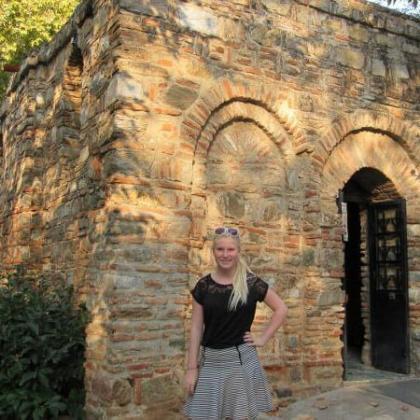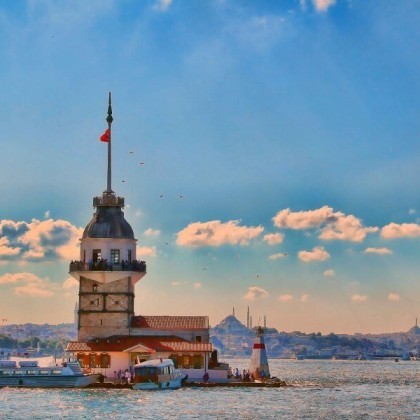Pergamon (Bergama)
The physical layout of Bergama, formerly ancient Pergamon, seems to reflect the ebb and flow of the city’s prosperity over time. A dazzling center of cultural activity in antiquity, Pergamon became the capital of the Roman province of Asia and had one of the two largest libraries in the ancient world. The ruins of this great Hellenistic and Roman city dominate the top of the hill. Buildings from later eras, when the city’s stature and importance declined, cling lower down at the hill’s feet. Greek houses, remnants of more prosperous days during the late-19th century, cluster around the tiny hills of the river banks before giving way to the cement buildings of modern Bergama. Unfortunately, in spite of having some of the most extensive and important ruins in Asia Minor, Bergama is often over looked. This quiet, attractive town suffers from severe economic depression, mostly due to its location off the main coastal highway and away from the sea, but its calm, unassuming quality, absent in many seaside towns, makes it worth a visit.
Pergamon traces its roots back to the Aeolian Greeks, who built a settlement here in the 9th century. Like many other ancient cities, Pergamon blossomed from the spoils of Alexander the Great’s conquest of the Persian empire. Alexander’s successor in the region, Lysimachus, deposited a hefty booty in the city under the care of Philetaerus, who rose from treasurer to ruler when Lysimachus did not return from battle. Philetaerus ruled fairly and generously, maintaining good rela¬tions with neighboring cities, and beautified Pergamon with temples and other new buildings. When he chose his nephew Eumenes I to succeed him in 263 BC, he established a royal dynasty that would last for five generations. This dynasty expanded Pergamon’s empire into Central Anatolia as far as Konya. By the 2nd century BC Pergamon had gotten itself into bed with the increasingly powerful Romans, and in 133 BC King Attalus II bequeathed the city to the Roman Empire. Under the Romans, Pergamon became the prosperous capital of the province of Asia. An earthquake in the 2nd century brought the city into a period of irreversible decline, however, and over the next several centuries it passed through the hands of the Byzantines, Crusaders, Lascarids, Arabs, Ottomans, and Greeks.
Istanbul New Year’s Eve Party Cruise on the Bosphorus
IstanbulWith this new year's eve party program in Istanbul, you will have an amazing new year party on the Bosphorus. Book it now and don't miss the special price!
View Tour3 Days Ephesus, Pergamon and Pamukkale Tour Package
Ephesus, Pamukkale, PergamonIf you want to make an amazing trip to the Ephesus, Pergamon, and Pamukkale, you should read our tour itinerary.
View TourIstanbul and Cappadocia Tour – 7 Days
Istanbul, Cappadocia, TurkeyIf you want to make a trip to Istanbul and Cappadocia both, we strongly suggest you join this amazing package tour. This tour covers all the accommodations, transportations, lunches...
View TourBest of Turkey Package Tour – 8 Days
Istanbul, Cappadocia, Ephesus, PamukkaleAre you looking for a good traveling package in Turkey? With our 8-days Turkey tour, you will make a trip to every important sight in Turkey. Enquire now for...
View TourTRANSPORTATION
Buses: At the garaj (633 15 45), across from Çamlı Park, about 1 km south of the old town on Izmir Cad. This distance is walkable, but taxi may be preferable ($2), To: Ankara (10hr., 9pm, $11); Istanbul (10hr.; 10am, 9:15pm; $13); Izmir (2hr., every 45min. 6am- 7:30pm, $2.25). A servis runs to the garaj from a smaller bus station near İstiklâl Meydanı. To get there, walk from the square and make the first major left. The bus station is a 2min. walk on your left. When traveling to Bergama, especially from the north, ask for a direct bus since some stop only at the Bergama turnoff on the main highway, 7km from the city. From the main highway, take a dolmuş to the center of town to avoid the heavy cab fare.
ORIENTATION AND PRACTICAL INFORMATION
The Pergamene Acropolis is across the river from the modem city of Bergama, while the Asclepion is uphill from Atatürk Meydanı, in the modem area. The city’s main road runs north-south, winding its way to the acropolis at. the northern end. From İzmir to the bus station the road is called İzmir Cad., from the bus station to the northern end of Atatürk Meydanı (the larger of the two squares), it is called Cumhuriyet Cad., and from the northern end of Atatürk Meydanı to İstiklâl Meydanı, it is called Bankalar Cad. Most, pensions and restaurants surround İstiklâl Meydanı.
- Tourist Office: (631 28 51). From the bus station, take a right onto İzmir Cad. and walk 1km to Cumhuriyet Meydanı. The office is on the left side of the road. Distributes a helpful map with all hotels and pensions labeled. Open M-F 8:30am-noon and l-5:30pm.
- Banks: On the left side of İzmir Cad., about 200m up from the PTT (away from the bus station) are TC Ziraat Bankası and Türkiye İş Bankası. Both exchange currency and have Cirrus/MC/Plus/V ATMs. TC Ziraat open M-F 9am-5:30pm. Money exchange closed noon-1pm. Türkiye İş open M-F 9am-12:30pm and 1:30-5:30pm.
- Hamams: The historic Haci Hekim, 32 Bankalar Cad. (632 10 75), is across from the banks. Reasonably clean, it serves Turkish men and tourists of both genders, and is worth a look even if you are not bathing. Bath and massage $7.50. Open daily 7am- midnight. Newly tiled and very clean, the Sprinter Sauna, 88 İzmir Cad. (632 36 48), south of the garaj, serves men and women, and is more comfortable for single female travelers than Hac! Hekim, thanks to the availability of female masseurs. Sauna, steam bath, Turkish massage, and full body massage $9. A cafe on the upper level serves hot and cold drinks. Take a dolmuş from the garaj and ask for the Serapion or Efsane Hotel, as both are nearby. Alternatively, walk south 500m on İzmir Cad. from the garaj. Open daily l-5pm for women, 8:30am-lpm and 5pm-midnight for men.
- Hospital: Bergama Devlet Hastanesi (®631 28 97 or 631 28 94). Walk from the bus station toward the PTT, turn left where the park ends, go uphill, and turn right.
- Police: (632 70 01), on Izmir Cad., just past the tourist office.
- Internet Access: Köşe Internet (s-631 08 84), on the road to the Asclepion, Galenos Cad., near the center of town. 10 computers at $1 per hr. Open daily 10am-midnight.
- PTT: (®632 39 90), on İzmir Cad. Some English spoken. Currency exchange (1% commission) until 5pm. Open daily 8:30am-11pm.
Postal code: 35700.
ACCOMMODATIONS
£3 Pension Athena, 5 İmam Çıkması, Barbaros Mah. Housed in a restored Ottoman home on the winding road beyond İstiklâl Meydanı to the left. 24hr. hot water, living room with cable TV, public kitchen, enclosed çay garden, and rooftop view of the Acropolis. Free map of town, compliments of the friendly management. Laundry $2.25-3. Excellent breakfast $1.50. Internet $.75 per hr. Rooms $4.50, with shower $5.50; a place to throw your sleeping bag out on the roof $1.50.
Böblingen Pension, 2 Asklepion Cad. (633 21 53), on the corner of İzmir Cad. and Asklepion Cad., on the left as you exit the garaj. A bit far from the center of town. Clean rooms with private bath. Bar on 4th floor with colorful, Ottoman-style seating. Breakfast included. $5.50 per person.
Berksoy Camping (633 25 95). Walk south on İzmir Cad. for 20-30min. No English spoken, so it’s probably best to inquire at the tourist office about availability. Amenities include pool and tennis courts. $2.50 per person. ©
FOOD AND ENTERTAINMENT
Bergama’s dining options, mostly family-style kebap and pide restaurants clustered around İstiklâl Meydanı, are often quite pleasant.
Sağlam 2 Restaurant, 3 İstiklal Meydanı (633 20 46). The Sağlam family has all but cornered the dining market, operating 2 restaurants in Bergama and 3 more in other cities. Sağlam 2 offers southeastern Anatolian cuisine, which you can watch being cooked in the traditional brick oven. Pide ($1-2.25) and kebaps ($1.50-2.50). Live Turkish music on some nights in upstairs bar. Open daily 8am-midnight. AmEx/MC/V.
Sağlam 3, 29 Hükümet Meydanı (632 88 97), on the right side of the street before the PTT as you walk north from the otogar. Expansive garden-style seating and 2 Ottoman dining rooms upstairs with rug-covered seats. Similar menu to Sağlam 2, but with more vegetarian options. Open daily 8am-midnight, sometimes later. AmEx/MC/V. ©
Arzu Pide Salonu, 10 İstiklâl Meydanı (©631 11 87). 5 kinds of pide ($1), lahmacun ($.50), and nothing else, with biggest portions in town. Dining area upstairs. Open daily 7:30am-10:30pm.
Pergamon Pension Restaurant, 5 Bankalar Cad. (©632 34 92). Soft chairs, bright floral table cloths, a small pool, and natural lighting from skylights add to the charm of this courtyard restaurant housed in an old Ottoman building. Serves meat dishes ($1.50- 2.50) and a variety of mezes ($1). Open daily 6am-11pm.
SIGHTS
ACROPOLIS
The acropolis of Pergamon looms over the city like a giant, inaccessible, brick- and-marble storm cloud, its treasures protected by steep hills and a high barbed wire fence. From a lower gate, the ancient, stone paved road climbs the hill, passing all the ruins and the current excavation sites. The walk up is better than a taxi ride ($5), which follows the modem paved road and misses half the sights. Start at the river (near the Athena Pension), cross the bridge, and proceed through the maze of the old town diagonally to the right and up the hill. Eventually you will meet the paved road that leads to the top. Follow’ it for a short distance until you reach a gate and a cluster of concrete buildings on the right, where the German excavation team lives and works. To the right of this gate, a little path runs between the road’s chain-link fence and the perimeter fence of the archaeological compound, eventually becoming a fairly easy to follow trail through the ruins.
Stay on this former Royal Road by following the blue dots painted on steps, walls, and other pieces of stone. The first, set of rectangular rains on the left is the lower agora, the center of the ancient city’s commercial trade. The trail here clings to two of the agora’s sides before making a sharp switch back to the right. Farther along is the gymnasium, a massive three-tiered complex of exercise halls and baths built on the hillside. In addition to providing a venue for physical exercise, Greek gymnasia also functioned as schools, training young men in philosophy and oratory. Young boys began in the lower gymnasium, today the least impressive and worst preserved of the three, and moved up to the middle level at around age 13. The upper level, built around a large, colonnaded exercise area, included a small theater, a lecture hall, and two bath complexes. In the center of the gymnasium, the largest room, and the most impressive of the ruins, was used for track and field competitions. The remains of the Temple of Demeter, marked by a few inscriptions, lie on the path uphill from the upper gymnasium. At the west end, animals were slaughtered as sacrifices to Demeter, the goddess of rebirth, harvest, and fertility.
From here, the road winds around the hill to the left, growing wider and more evenly paved up to the now tree-covered Altar of Zeus, built by Eumenes II in commemoration of Attalus’s victory over the Gauls. All that remains today are the first four or five tiers of steps on the base; Germans carted off the columns and giant friezes to Berlin, where they have been incorporated into an impressive restoration of the temple. The ticket booth is off to the right, facing the big temples and the city walls. The Precinct of Athena, the rectangular ruin closest to the ramp leading from the entrance gate, was the site of Pergamon’s famed library.
Carved into the hill for an impressive effect when viewed from the road, the Hellenistic Theater once seated 10,000 in nosebleed comfort. Above the theater, the giant Temple of Trajan was built for both the cult of Zeus and the imperial cults of Trajan and Hadrian. On the steep bluffs behind the temple were the foundations of the various royal palaces of the Attalids, which used to extend into the area now covered by the Temple of Trajan, and a wishing well. Wishers throw three coins at the column in the well; supposedly, a wish will come true if one lands on the top.
C’MON BABY LIGHT MY FIRE
Great was the Alexandrian’s jealousy over the Pergamenes’ literary hoard that they made what they thought was a brilliant strategic move: they limited the flow of Egyptian papyrus to Pergamon. The Pergamenes countered by writing all their subsequent volumes on parchment pages made from goat hide, an exponentially more durable, though more expensive, material. The scheming Alexandrians, however, were only temporarily foiled. When the Alexandrian library’s fire suppression mechanism experienced a system-wide failure, Marc Antony plundered Pergamon’s shelves and presented the whole library to Cleopatra, presumably as a token of his love. In 640, the ill-fated collection was put to the torch by the Caliph Omar and his lieutenant, the aptly named Amr ibn al-Ass. Subscribing to a kind of witch-trial logic, Omar decreed that if the books agreed with the Qur’an, they were unnecessary, and if they disagreed with the Qur’an, they were heretical and fit for combustion. Innumerable works of ancient literature went up in flames and were lost forever, including dozens of plays by Sophocles, Euripides, and Aeschylus.
ASCLEPION AND BERGAMA MUSEUM
Asclepion open 8am-6:30pm. $2.25, students free. The refurbished Bergama museum is toward the bus station about 100m from the Bergama tourist office. Open Tu-Su 8:30am- 6:30pm. $1.25, students free.
Pergamon’s famed Asclepion lies on the west side of town, a relatively easy uphill walk off Atatiirk Meydani, at Galenos Cad. The Asclepion was a shrine to Asclepius, the Greek (and later Roman) demi-god of healing. After the center at. Epidauros in Greece, Pergamon’s Asclepion was the most famous healing center in the ancient world, and its native son Galen was the foremost doctor of his time. An avid promoter of animal dissection and vivisection, Galen served as Asclepion’s chief physician. His treatises and theories became the foundation for medical thought in Europe and the Middle East until the mid-17th century.
The site begins with the Via Tecta, a broad, colonnaded street connecting the Asclepion with Pergamon proper. Pergamon leads first to the Propylon, a small,
CLAIRVOYANT CREATURES
Strolling along the harbor road of any town along the Aegean, you’re bound to come across a fortune-telling rabbit, though it looks like any ordinary bunny. In the gypsy tradition that brought you the dancing bear, these rabbits are trained by street peddlers to pick out a slip of paper from among rows of them, on which is written a detailed fortune. These days, many bunnies have gone multilingual, predicting the future in Turkish, English, and German. Arrange a price in advance, or you may well end up paying a fortune yourself.
square building thought to have contained a cult statue of Asclepius. Next door is the library, which houses a number of stelae covered in Greek inscriptions. Up the stairs to the left is the cylindrical Temple of Asclepius, modeled on the Roman Pantheon, and further still is the healing center, which consists of six semicircular chambers radiating in a flower-like arrangement from the central domes. Ailing visitors to the Asclepion took part in a kind of dream therapy known as incubation: sleeping in the temple, they would be visited in dreams by Asclepius. These dreams, later interpreted by one of the Asclepion’s priests, revealed the appropri¬ate treatment, usually a changed diet, hot or cold baths, mud bathing, and exercise. An impressive and perfectly preserved underground tunnel links the healing center to the rest of the complex. The theater, which held 3500, staged lectures and other entertainment for the benefit of patients and local citizens.
The museum, arranged like a Roman villa, surrounds a small, perfectly maintained central courtyard. Grave and dedicatory stelae line the surrounding halls. The main room of the museum, at the far end of the courtyard, presents an eclectic collection, including sculptures, glassware, an extensive coin collection, and a large, world-renowned Medusa mosaic. The adjacent Ethnography Museum, with its poor lighting and lack of English descriptions seems almost like an afterthought in comparison to the main museum, although it does contain interesting costume displays and one English-language explanation of the carpet-weaving process.
KIZIL AVLU (RED BASILICA)
Open daily 8:30am-6:30pm. $1.50, ISIC holders free.
The remnants of Kızıl Avlu, a pagan temple, stand near the river, İstiklâl Meydanı, and the old part of Bergama. “This is where Satan has his altar,” declares Revelations, citing Kızıl Avlu as one of the Seven Churches of the Apocalypse. This mammoth structure was built in the first half of the 2nd century AD and is dedicated to the Egyptian trio of gods Scrapis, Isis, and Harpocrates. At its far end once stood a talking statue of Serapis; priests would climb into the hollow figure to make it “speak.” With the advent of Christianity, Kızıl Avlu was converted into the Church of St. John, receiving its twin towers sometime during the Byzantine period. One of these is now a mosque.





